|
|
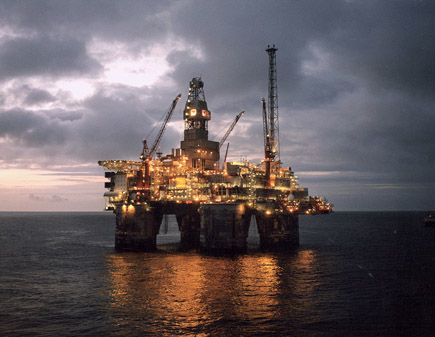 [Image: Courtesy of Statoil]. [Image: Courtesy of Statoil].
I was flipping through a copy of Archive the other night when I came across a spread of recent print ads by Norwegian oil giant, Statoil. The ads featured cities and skyscrapers and the Roman Colosseum all Photoshop'd perfectly onto offshore oil derricks; they looked like instant and futuristic offshore micro-utopias – or perhaps even some weird, mechano-robotic version of Arnold Böcklin's Isle of the Dead.
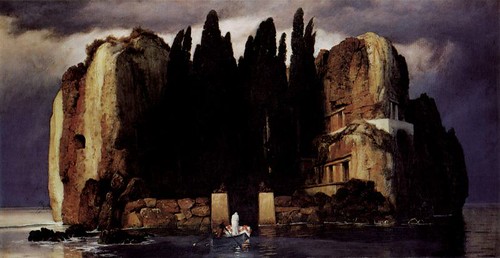 [Image: Arnold Böcklin]. [Image: Arnold Böcklin].
In any case, I wanted to post the ads here – but all I could find online were Statoil's own press images. Those, however, induced a kind of minor panic attack, as the offshore structures they document easily rival, and possibly surpass, the most far-fetched architectural speculations of Constant Nieuwenhuys.
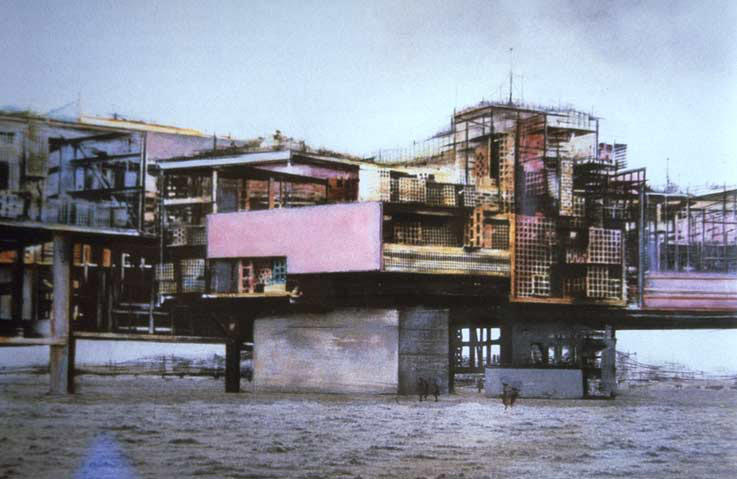 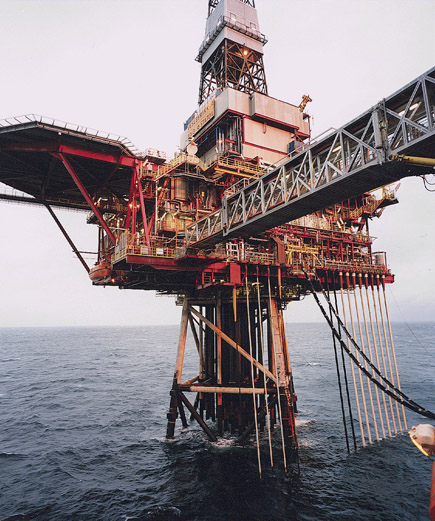 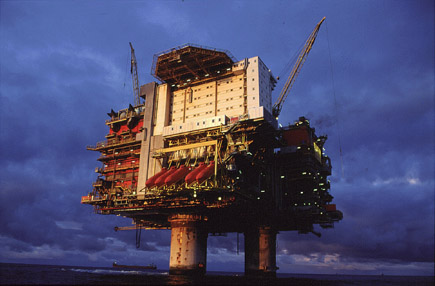 [Images: Constant vs. Statoil]. [Images: Constant vs. Statoil].
So here are some photos – and anyone who runs across online versions of the Statoil ads, let me know.
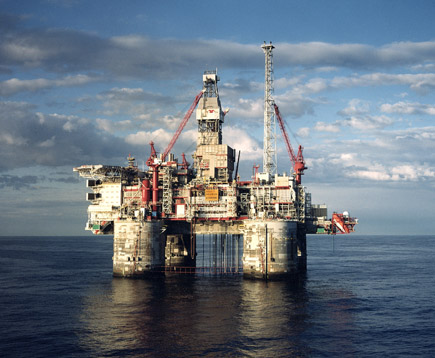 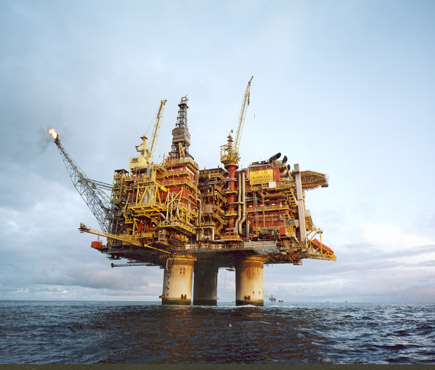 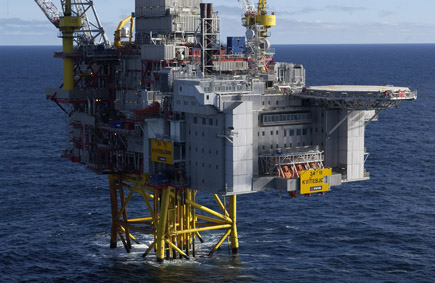 [Images: Courtesy of Statoil]. [Images: Courtesy of Statoil].
These next two shots were actually taken inside the legs of one of the derricks; as such, the photographer is standing below sealevel.
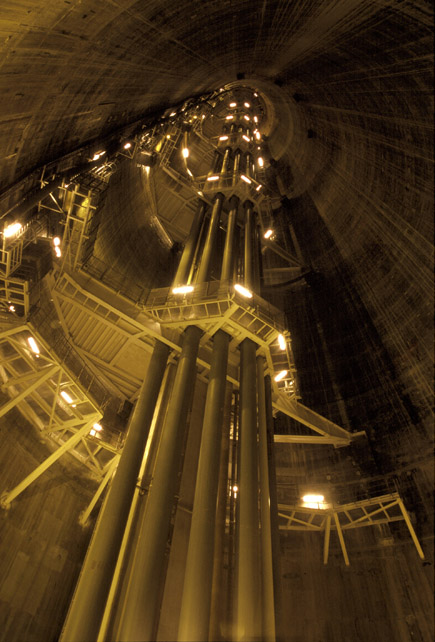 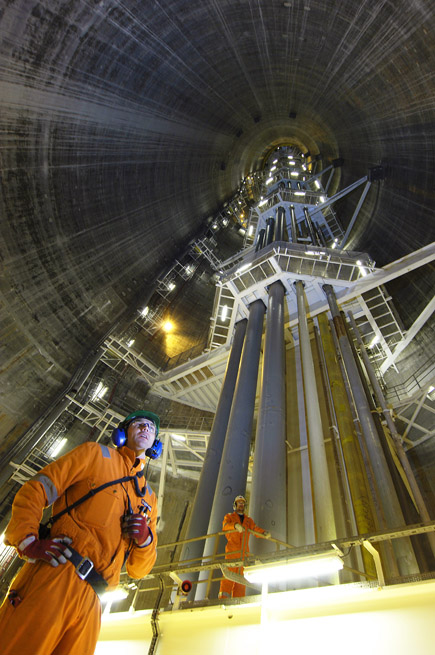 [Images: Courtesy of Statoil]. [Images: Courtesy of Statoil].
But then I got to thinking how, toward the beginning of The Aeneid, we read that Aeneas and his crew have been tossed about by a string of storms and bad navigation, moving island to island against their will:
For years
They wandered as their destiny drove them on
From one sea to the next... They are accidental exiles, always docking on the wrong shore.
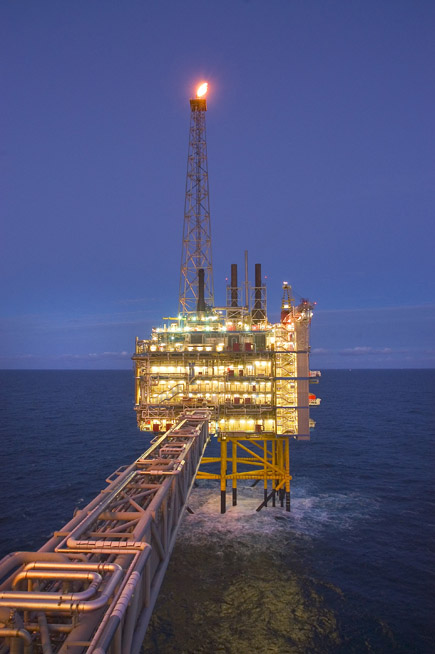 [Image: Courtesy of Statoil]. [Image: Courtesy of Statoil].
Unsurprisingly, Aeneas is soon fed up with trying "[t]o learn what coast the wind had brought him to," so he confronts a random islander – not realizing that it's actually his mother (his mom happens to be Venus, and she likes to wear disguises). He demands:
Tell us under what heaven we've come at last,
On what shore of the world are we cast up,
Wanderers that we are, strange to this country,
Driven here by wind and heavy sea. Etc. etc. – it's the endless drama of origin and detour.
My point is simply: how might the Aeneid have been different if the Mediterranean Sea they'd explored had actually been full of oil derricks, a manmade geography of machine-islands, industrialized stilt-kingdoms each more fantastic than the rest – and so they'd set sail beneath the anchored legs of support understructures and maintenance gantries, roping up their ships for the night in the shadow of artificial hills and disguised islands? An Aeneid for the machine age.
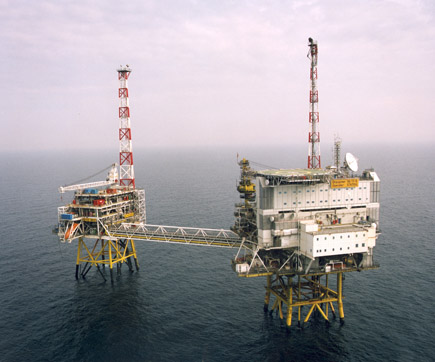 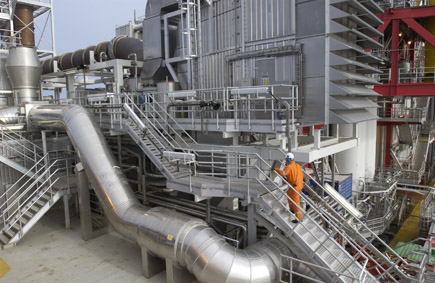 [Images: Courtesy of Statoil]. [Images: Courtesy of Statoil].
More practical questions include the reuse of these structures: what unintended future functions might these aging derricks be repurposed for? Once their fields run dry, will they be left standing till inevitable collapse? Or will a maritime preservation movement swoop in to save them?
Further, will corporate tax havens of tomorrow be built at sea, in private archipelagos of platform-cities, an experimental terrain for new concepts of financial sovereignty?
[Note: Just to be absolutely clear here, all images of oil derricks used in this post come courtesy of Statoil].
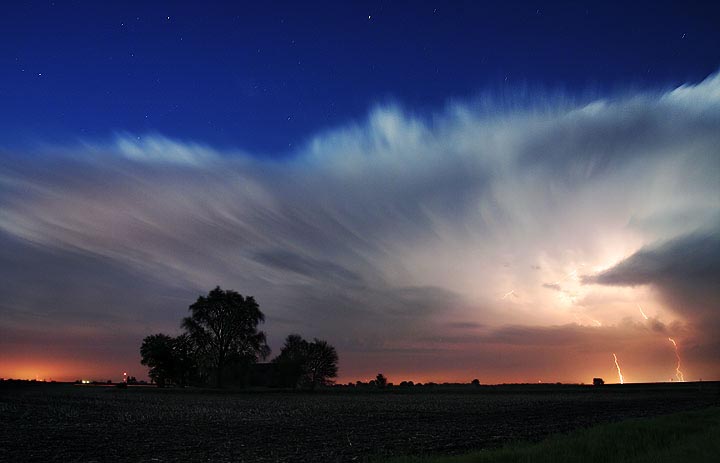 [Image: A passing Illinois lightning storm and supercell, the clouds peeling away to reveal evening stars; photo ©Extreme Instability/Mike Hollingshead. If you can overlook pet photos, meanwhile, don't miss Hollingshead's other storm work from 2006 and 2005 – including these Nebraskan auroras. While you're at it, this storm sequence has some stunning, pre-storm landscape shots]. [Image: A passing Illinois lightning storm and supercell, the clouds peeling away to reveal evening stars; photo ©Extreme Instability/Mike Hollingshead. If you can overlook pet photos, meanwhile, don't miss Hollingshead's other storm work from 2006 and 2005 – including these Nebraskan auroras. While you're at it, this storm sequence has some stunning, pre-storm landscape shots].
During a disastrously moderated talk at the MAK Center last night in West Hollywood, where the panelists could hardly get a word in edgewise because of the barely coherent, self-answering, 40-minute monologue of the moderator, Karl Chu briefly managed to say that he was interested in constructing and designing whole continents and weather systems.
Which got me thinking.
Given time, some digging equipment, a bit of geotechnical expertise, and loads of money, for instance, you could turn the entirety of greater Los Angeles into a weather bowl, dedicated to the recreation of famous storms. Install some rotating fans and open-air wind tunnels, build some deflection screens in the Hollywood Hills, scatter smaller fans and blowers throughout Culver City or overlooking Burbank, amplify the natural sea winds blowing in through Long Beach – and you could re-enact famous weather systems of the 18th and 19th centuries, reproducing hurricanes, even bringing back, for one night, the notorious storm that killed Shelley.
You consult your table of weather histories, choose your storm and go: fans deep in hillsides start turning, the wind tunnels roar, and lo! The exact speed and direction of Hurricane Andrew is unleashed. Seed the clouds a bit and reprogram the fans, and you can precisely reproduce the atmospheric conditions from the night William Blake was born. Or the ice storm that leveled electrical gantries outside Montreal, now whirling in a snow-blurred haze through Echo Park.
You could build competing weather colosseums in London, San Francisco, Tokyo, and Beijing. Every night new storms are reenacted, moving upward in scale and complexity. The storm Goethe saw as a nineteen year-old, contemplating European history, kills a family of seven outside Nanking. You soon get Weather Olympics, or a new Pritzker Prize for Best Weather Effects.
One day, a man consumed with nostalgia hacks the control program to recreate the exact breeze on which he once flew a kite over the Monbijouplatz in Berlin...
(For more on the construction of continents, see The Transgondwanan Supermountain. For more on the exhibition now up at the MAK Center, download this PDF).
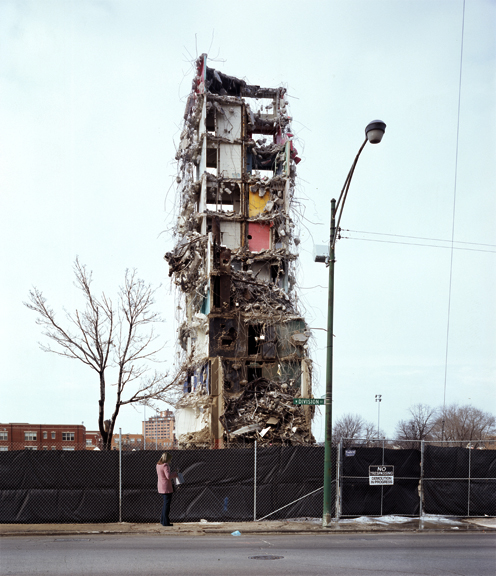 [Image: The old tower blocks of Chicago's Cabrini-Green, transformed by demolition into totem pole-like wind instruments, flute-ruins, a musically-active wasteland whistling to itself behind security fences. Photographer unknown; spotted at Archinect. It seems worth briefly pointing out, however, that Cabrini-Green could instead have been architecturally salvaged and later reused—and, given a different economic model, the towers could also have been refurbished. Indeed, through that latter link we learn that the combined weight of London's existing tower blocks is an astonishing forty million tons—meaning that high-rise building materials constitute a near-geological presence in many cities, and they should not simply go to waste...]. [Image: The old tower blocks of Chicago's Cabrini-Green, transformed by demolition into totem pole-like wind instruments, flute-ruins, a musically-active wasteland whistling to itself behind security fences. Photographer unknown; spotted at Archinect. It seems worth briefly pointing out, however, that Cabrini-Green could instead have been architecturally salvaged and later reused—and, given a different economic model, the towers could also have been refurbished. Indeed, through that latter link we learn that the combined weight of London's existing tower blocks is an astonishing forty million tons—meaning that high-rise building materials constitute a near-geological presence in many cities, and they should not simply go to waste...].
Wired reveals what "a permanent presence in the ocean" might look like, if that "presence" consisted entirely of manmade submersibles. 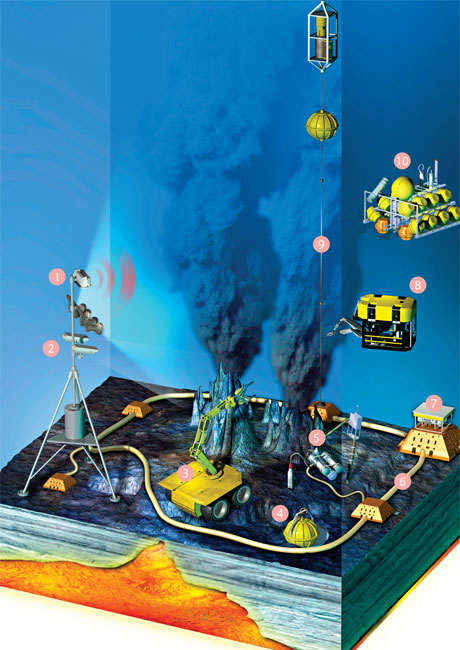 [Image: From Wired]. [Image: From Wired].This underwater robotic metropolis is otherwise known as the NEPTUNE Project. Specifically, Wired writes, the project "would string 10 semiautomated geobiological labs across the Juan de Fuca tectonic plate off Washington, 8,000 feet underwater. Each would have cameras, lights, robots, and sensors, all connected to the surface via optical cable to transmit data on everything from the biomass of microbes to the effects of ocean temperature on weather." According to the project's own website, the "goal is for NEPTUNE to appear as a seamless extension of the global Internet, connecting users anywhere on shore to the sensors on the seafloor." 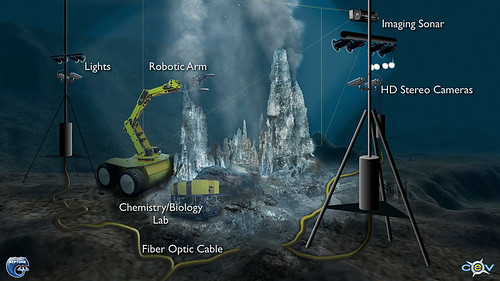 [Image: A future seafloor exploratorium. Image provided courtesy of the NEPTUNE Project and produced by CEV]. [Image: A future seafloor exploratorium. Image provided courtesy of the NEPTUNE Project and produced by CEV].As Space.com reported back in 2003, "the network itself will cover a region roughly 310 miles by 620 miles (500 kilometers by 1,000 kilometers) in size. More than two dozen experimental sites will form nodes along the sub-sea cable system. Nodes will be situated about 62 miles (100 kilometers) apart" – making the whole thing only slightly smaller than Great Britain. On the other hand, the NEPTUNE Project should be thought of as a terrestrial analog for other, more far-flung, research stations: according to John Delaney, for instance, a similar set-up could be used to explore the oceans of Europa (about which more can be found here). Given some oxygen tanks, it could also be the perfect location for a new public lecture series on architectural design... (Not quite related: Open Ocean Aquaculture).
Apparently this sound (which I can only hear through headphones) is causing quite a stir in the northern districts of Auckland. The sound is so maddening, it seems, that it's inspired some residents "to take drastic action" – which, in one case, means purposefully deafening oneself with the roar of chainsaws. In fact, "for those who can hear it, the sound is the bane of their lives." 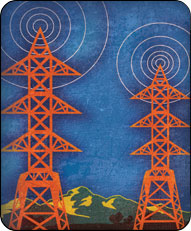 The sound also reveals where unexplained acoustic phenomena, dishonesty, and urban real estate intersect: "Some have been reticent to give away more details of their predicament for fear that reports of persistent humming could adversely affect the resale price of their homes." One of the researchers trying to locate the sound's origins "rules out geological factors. 'It's more likely to be things like pipes under the ground – you know, gas pipes, sewerage pipes, factories in the distance.'" CIA installations, perhaps. "This is not the first incidence of humming in New Zealand," we're told. Oh, no. "In 2005, New Zealand author Rachel McAlpine wrote a book called The Humming... largely inspired by the author's own experiences in the seaside town of Puponga on the northwest tip of New Zealand's south island which was itself at the centre of a humming mystery some years back." That man was later arrested. In McAlpine's novel we read how "life is becoming increasingly frustrating for [a character named] Ivan because he is plagued by an underground humming that he tries to disguise with an increasingly bizarre array of devices." If it were my story to re-tell, however, Ivan would soon become so unbelievably good at manufacturing sonic camouflage that he turns into the terror of post-Blair Great Britain. (He moves to Britain). Completely silent, exploding noiseless weaponry over the city of Birmingham, Ivan's Joseph Conrad-inspired, acoustically avant-garde ransom demands are met not with payment stashed inside a pre-arranged safety deposit box – but by a visit from a certain, rather well-known, secret agent of the crown... Unfortunately, James Bond is almost immediately captured – having been dumbfounded by a house full of mirrored rooms, someone else's mobile phone, and a weird echo, coming as if from behind him, that induces a state of cognitive paralysis. Bond is then subjected to a series of unbearable noise-tortures, leading some in the audience to laugh and others to accuse the film of being an unacknowledged remake of The Ipcress File. But, once the enemy is brought back on screen, transformed by his life of sonic dissimulation, he addresses Bond through a grotesque series of hand-held voice-cancellation machines – and we see that something altogether more terrifying has been planned... Of course, it has long been known that if you "listen carefully... you can hear the Earth singing quietly to itself." They live underground. They are everywhere but seem to come from nowhere. They barely exist, but never leave. If sounds have shadows, they are the shadows of a sound. Researchers call them the background free oscillations of the Earth. These "background free oscillations," however, while more or less totally unrelated to the New Zealand drone, discussed above, are also unexplained. This endless terrestrial resonance could be "buildings shuddering in the wind," for instance – or it could be "the constant throb of fluctuating atmospheric pressure all over the Earth." It could even be the combined effect of all the oceans' waves crashing on all the earth's shores simultaneously. It could even – though let me pull the blinds closed as I write this – it could even be the rumble of invisible stealth bombers breaking the sound barrier out at sea... (Thanks, Marcus! Earlier: Sound Dunes, Dolby Earth, and so on).
Though it's kind of insane to post this here, I was excited nonetheless to see that BLDGBLOG is featured in the new Blackberry Pearl ad campaign... 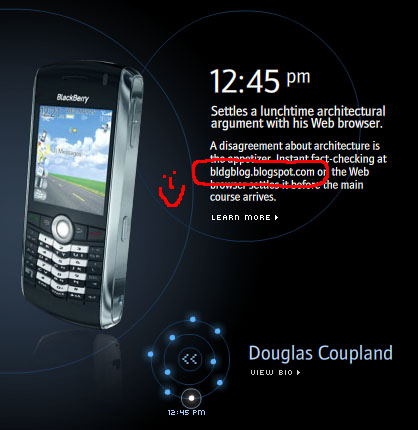 It pops up in the context of author Douglas Coupland's everyday telephonic activities; at 12:45pm, according to the little Flash animation, Coupland "settles a lunchtime architectural argument" by going to BLDGBLOG.  The logo's so bigtime they got shy and hid the other half... That's right. So I'm retiring on the royalties to Brazil, where I'll re-reverse the flow of the Amazon River and report back in a few years' time. (Thanks, Douglas!)
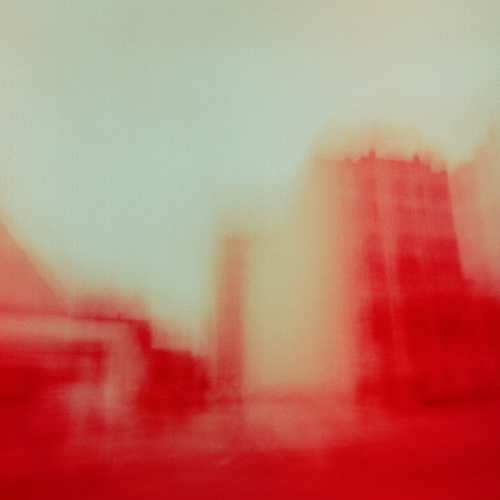 [Image: By Nicolai Grossman, of Photon Detector fame]. [Image: By Nicolai Grossman, of Photon Detector fame].Like some weird cross between the Bible, William Blake, and a botanical Finding Nemo, the British landscape is alive with plants that escaped from gardens: "About one-quarter of plants sold to ornamental gardeners since the 1800s have escaped, and 30 per cent of these are firmly established in the English countryside." It seems these inadvertant landscapes-at-a-remove could actually have been financially predicted; historical researchers "found that the odds of escape increased with how widely available and inexpensive a given plant was at the time." Leading me to wonder if a similar approach, today, could be used to plot prices of wildflowers, garden herbs, and domestic tree species against the projected future landscape of Ohio, say, or Brecon, Wales: price-maps as a subset of future landscape geography. Speaking of future landscapes, New Scientist's look at an earth without humans was republished and discussed everywhere last week – but, in case you missed it, here's a link. From the article: "Left once more to its own devices, Nature would begin to reclaim the planet, as fields and pastures reverted to prairies and forest, the air and water cleansed themselves of pollutants, and roads and cities crumbled back to dust." 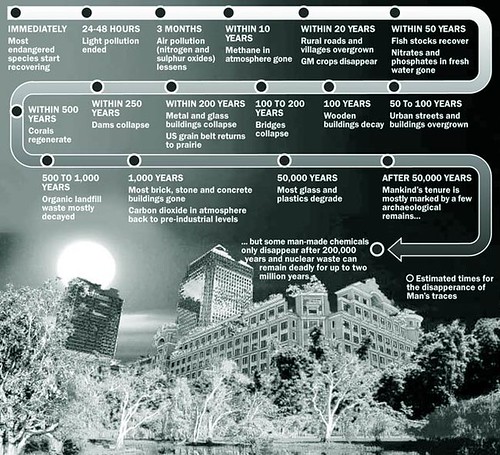 [Image: A related graphic, from the Times Online]. [Image: A related graphic, from the Times Online].Further: "If tomorrow dawns without humans, even from orbit the change will be evident almost immediately, as the blaze of artificial light that brightens the night begins to wink out. (...) The loss of electricity will also quickly silence water pumps, sewage treatment plants and all the other machinery of modern society." The same lack of maintenance will spell an early demise for buildings, roads, bridges and other structures. Though modern buildings are typically engineered to last 60 years, bridges 120 years and dams 250, these lifespans assume someone will keep them clean, fix minor leaks and correct problems with foundations. Without people to do these seemingly minor chores, things go downhill quickly. Of course, ten years ago New Scientist offered a very similar look at what would happen if London was abandoned to the marshes and earthworms. "Within the first year," we read, "dandelions and other weeds begin growing in the gutters and emerge from the cracks caused by frost and flooding in concrete, paving slabs and walls." Fair enough. "Within five years," however, "roads, pavements parking places and the great squares of the city are carpeted with weeds and a rich turf of clover." Then, an "understorey of grasses and shrubs gradually spreads over the city. As the soil layer builds up, deeper-rooting plants take hold. Trees start to grow and their roots smash through what's left of the pavement and tarmac," until the whole of London looks more like Angkor Wat, or the lost city of Z, than it does Notting Hill. Etc. etc. The article's parting shot: "In a flood plain like London's, inundation of foundations and natural soil movements would leave very few buildings standing after 1000 years. By that time, both the oak and the floodplain forests would be mature and the rubble of Canary Wharf would have sunk into the marsh." (See Silt for more on a flooded London). Speaking of ruined cities, meanwhile, Pruned introduces us to a new boring machine – that is, a new machine that bores tunnels. Quoting from both Pruned and the project brief, the machine's designer, we learn, hopes: [to] deploy a robot to cities devastated by an earthquake, whereupon this "burrowing robot negotiates through the unstable rubble and solid earth, creating an interred, inhabitable structure from recycled debris. The raw system left behind by the robot provides a basic framework for shelter, infrastructure, and structural stability in an upheaved landscape. The resultant system is a landscape of interconnected spaces ready for human colonization." The machine would look like this: 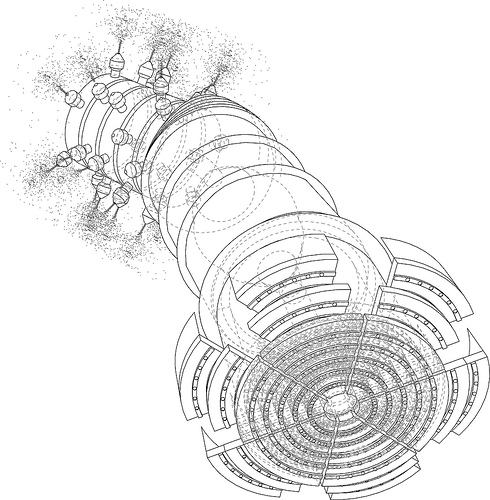 [Image: From The Reinterred City]. [Image: From The Reinterred City].There are many more images available at the project's Flickr page. Whilst pondering that mechanism, don't forget that the Pamphlet Architecture 29 submission process is still open. So get published. And whilst you're pondering that, don't miss this year's Next Generation competititon, sponsored by Metropolis: The 2007 Next Generation® prize will finance the development of a bright idea that focuses on ENERGY, its uses, reduction, consumption, efficiencies, and alternatives. (...) On your own or in teams we invite you to submit work on urban plans, buildings, interiors, products, landscapes or communications design. The winner will receive $10,000 to realize his or her idea, and will be featured in Metropolis magazine. One place you could start: is thorium the clean energy source of the future...? Returning to William Blake – who once declared that "Energy is Eternal Delight" – the November 2006 issue of Wired features a fantastic article about Darren Aronofsky's new film, The Fountain. In the article, author Steve Silberman describes how Aronofsky, determined to represent galactic space without the use of computerized special effects, came upon the work of Peter Parks, "a marine biologist and photographer who lives in a 400-year-old cowshed west of London": Parks and his son run a home f/x shop based on a device they call the microzoom optical bench. Bristling with digital and film cameras, lenses, and Victorian prisms, their contraption can magnify a microliter of water up to 500,000 times or fill an Imax screen with the period at the end of this sentence. Having then constructed their own kind of universal microcosm, using "yeast, dyes, solvents, and baby oil, along with other ingredients they decline to divulge," these DIY home f/x producers filled the end of Aronofsky's film with "galactic clouds and pillars of dark matter that look like nothing else in science fiction." 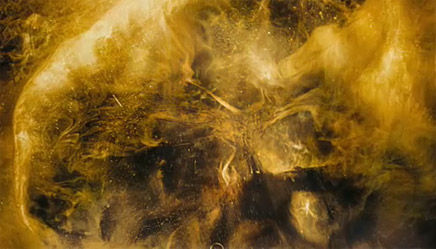 [Image: From The Fountain]. [Image: From The Fountain].Such an approach gives The Fountain's grand finale "a handwrought quality that evokes the luminous etchings of William Blake." Turning our eyes away from space, toward the center of our own planet, we read that the "first known organisms that live totally independently of the sun have been discovered deep in a South African gold mine. The bacteria exist without the benefit of photosynthesis by harvesting the energy of natural radioactivity to create food for themselves." They apparently "live in ancient water trapped in a crack in basalt rock, 3 to 4 kilometres down." Speaking of energy and the center of the earth, it's never too late to revisit Manhattan's (only?) geothermally powered townhouse: 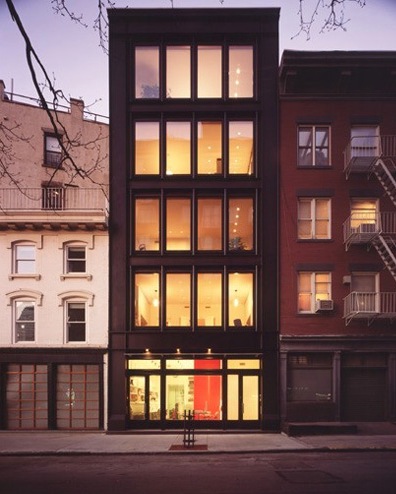 [Image: From the Wall Street Journal]. [Image: From the Wall Street Journal].According to the Wall Street Journal, the building's "unusual geothermal energy system provides heating, cooling and hot water. Pipes extend about 1,400 feet into the earth, where the temperature is always about 52 degrees... The pipes transfer energy to the house, where two-layer-thick concrete exterior walls, filled with thermal materials, trap the energy and distribute it." Finally, part of Turkey's new Marmaray Rail Tube Tunnel, set to open in 2010, will cut beneath the Bosporus strait. 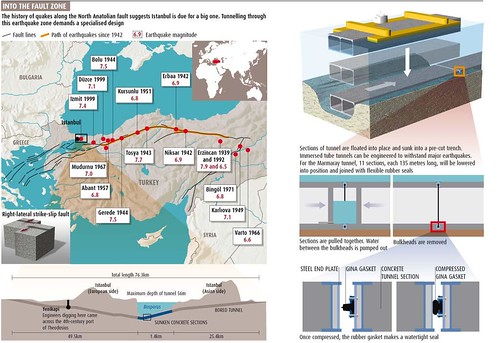 [Image: A visualization of project specifics; from New Scientist]. [Image: A visualization of project specifics; from New Scientist].The Marmaray rail link "will not only be the deepest underwater tunnel ever constructed," it "will also pass within 16 kilometres of one of the most active geological faults in the world." Indeed, "the abutting plates move about 2 to 3 centimetres relative to each other every year." However, using "flexible joints made from thick rubber rings reinforced by steel plates," the central section, passing under the waters between Europe and Asia, will hopefully survive any major quakes. Or hopefully not, if you like disaster/rescue films. Much more information available at, yes, New Scientist. (Thanks, Bryan!) [Earlier: Quick list 4 and so on].
Austria's relatively new dasparkhotel is an inn "constructed from repurposed, incredibly robust drain pipes." 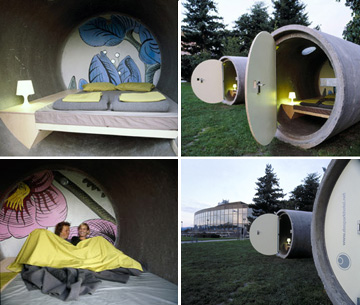 Each pipe's Zen-like "external simplicity," we're told, "surrounds an unexpectedly comfortable interior – full headroom, double bed, storage, light, power, woolly blanket and light cotton sleeping bag. All other hotelery devices (toilets, showers, minibar, cafe, etc) are supplied by the surrounding public space." Which means you piss in the bushes...? In any case, dasparkhotel uses "simultaneously functional and comfortable concrete sleep-pipes" – or architecturally repurposed drains – to "offer the chance to experience a place in a totally new way." 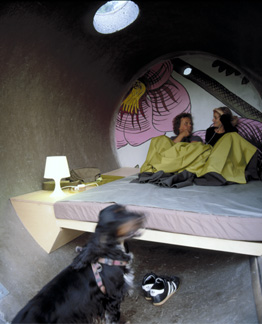 According to Wallpaper, the hotel is "a big hit among passing canoeists." (Via Archinect).
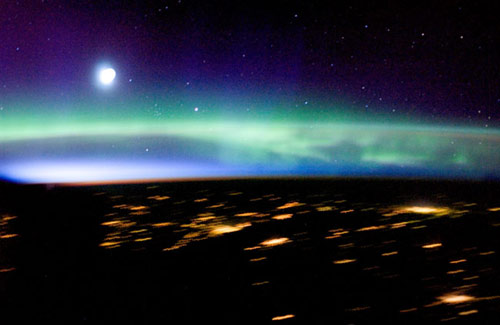 [Image: "An aurora borealis and the lights of Finland, Russia, Estonia and Latvia are featured in this digital still picture taken by the Expedition 11 crew aboard the International Space Station." In addition to cities, you can see the moon, the Beehive Cluster, and the planet Saturn, the latter shining just above the green magnetized wisps of the northern lights. Via Space.com]. [Image: "An aurora borealis and the lights of Finland, Russia, Estonia and Latvia are featured in this digital still picture taken by the Expedition 11 crew aboard the International Space Station." In addition to cities, you can see the moon, the Beehive Cluster, and the planet Saturn, the latter shining just above the green magnetized wisps of the northern lights. Via Space.com].
 As many of you will no doubt know, I interviewed photographer David Maisel back in March for Archinect. As it happens, Maisel has a new show of photographs opening up this weekend at the Paul Kopeikin Gallery in Los Angeles (6150 Wilshire Boulevard), and he'll be at the gallery tomorrow night, October 21st, from 6-8pm. The show consists of shots from Maisel's series Oblivion: reverse-printed aerial views of Los Angeles. As Maisel explains in the Archinect interview, Oblivion "was realized in a post-9/11 time period, so seeing the urban world from the air simply was not the same as it might have been a few years earlier." Further: Getting permission to fly over the city was fraught with difficulty; the possibility of an airplane somehow turning the urban fabric into the site of an Armageddon-esque conflagration was implicit. At the same time, the meaning of "looking" within an urban environment has changed; it’s now more akin to an act of surveillance. Who gets to look? Who controls the gaze? Who controls the information seen? Who is or is not permitted to photograph the railroad tracks, the subway station, the public building? Is it unlawful to do so without permission? And who, or what entity, is given the power to grant such permission? By what authority is that bestowed? 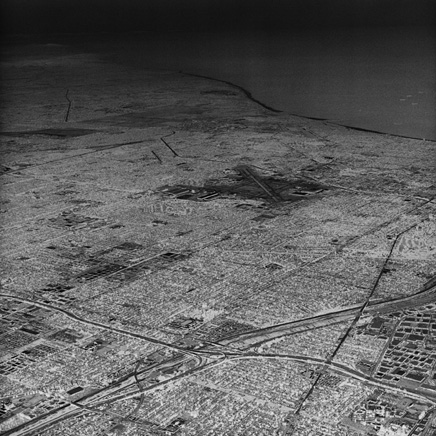 Elsewhere, on his own website, Maisel adds: "Certain spatial fears seem endemic to the modern metropolis, and Los Angeles defines this term in ways that no other American city can approximate. This amorphous skein of strip malls and gated developments, highway entrance and exit ramps, lays unfurled over the landscape like a sheet over a recalcitrant cadaver. Surely the earth is dead beneath the sheer weight and breadth of this built form?" 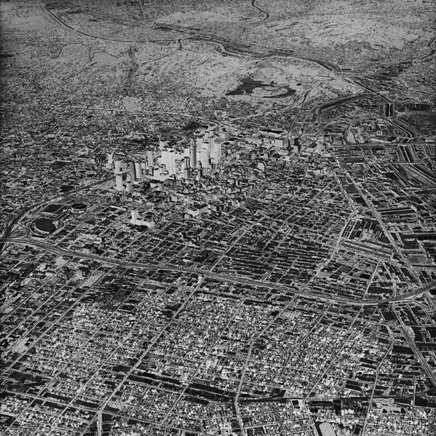 Finally, Oblivion is simultaneously being released in book-form by the Nazraeli Press. There, in an essay accompanying Maisel's photographs, author William L. Fox (the same William L. Fox discussed here) suggests that the tonal inversion so apparent in the Oblivion series works to disrupt the"circuitry of the city": The skyscrapers of downtown are now axonometric figures in a virtual reality, as if displayed in a Computer Aided Design program, and the course of the Los Angeles River is indistinguishable from those of the freeways. The oblique view... lays out a city as elaborate as that of a Persian carpet, yet it is as white as if it had been incinerated. What presumably is a blown-out, overexposed sky above the hills in the background is instead a black void that glowers over the city. It’s how an X-ray looks, how we imagine the military sees the monochromatic world when surveilling it at night. It’s as if we are seeing what the artist refers to as a “shadowland,” a place previously unobserved that coexists with its sunstruck version. So come out if you can, meet David (and possibly meet William Fox?), and potentially even meet me, though I'll just be there as a spectator. It should be a good night. Bring your friends, your Romans, your countrymen – as well as a few bucks so you can buy a signed copy of the book.
 Sun Sun has announced their Project Blackbox: a modular, prefab, stackable, shipping container-based, portable supercomputing and data storage warehouse – ideal for pirate utopias. "After today," they say, "you'll never look at an ordinary shipping container quite the same way again. Project Blackbox is a prototype of the world's first virtualized datacenter – built into a shipping container and optimized to deliver extreme energy, space, and performance efficiencies." Project Blackbox is "a glimpse into the fast, cost-effective datacenter deployments coming in the near future." Somewhat incredibly, "[t]he Project Blackbox prototype is a computing powerhouse capable of hosting a configuration that would place it among the top 200 fastest supercomputers globally."  Outdoing Archigram – who once dreamed of air-lifting whole prefab command/control systems into the wild, where, at the push of a button, computerized instant cities and other "plug-inscapes" could take form – Sun continues: Project Blackbox packages compute, storage, and network infrastructure capabilities into scalable, modular units outfitted with state-of-the-art cooling, monitoring, and power distribution systems. Customers will be able to order a variety of standard and custom configurations of systems, storage, networking, and software. Housed in a standard 20-foot shipping container for maximum flexibility, Project Blackbox will be easily transported using common shipping methods. Simple hookups for water, AC power, and networking will enable customers to quickly deploy Project Blackbox upon delivery.  I've ordered eleven. (Via Boing Boing).
In his book Terra Antarctica – previously discussed here – author William L. Fox takes us to an Antarctic field research city called, appropriately, Pole. This geodesic-domed instant city is built on Beardmore glacier – which, Fox writes, is "a ferocious uphill maze riven with thousands of crevasses," where high-speed winds are caused not by weather in any real sense of the word, but by "dense cold air sliding off the interior toward the coast via gravity." 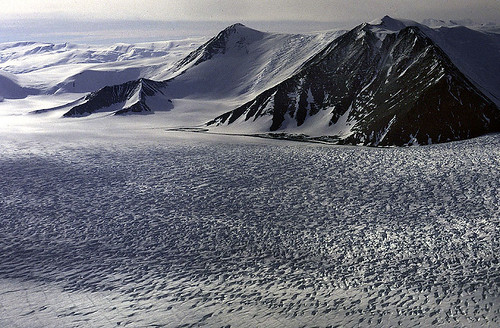 [Image: "Beardmore Glacier, slicing its way through the Transantarctic Mountains." Via Glaciers of the World]. [Image: "Beardmore Glacier, slicing its way through the Transantarctic Mountains." Via Glaciers of the World].Pole itself is an agglomeration of Jamesway huts, "corrugated metal tunnels" slowly blown over with snow, and the massive geodesic dome for which the city has become most famous. The dome is not precisely architectural, on the other hand: "The station is more like a raft floating on a very slow moving sea of ice two miles deep than a traditional building footed on the ground." It is structure imposed upon frozen hydrology: the insufficiently modeled glacial surface undergoes complicated deformations, thwarting all attempts to achieve longterm stability. It's a kind of ice seismology. In any case, one of the most interesting aspects of the whole thing is actually found below the city, in Pole's so-called "sewage bulbs." To quote at length: Water for the station is derived by inserting a heating element – which looks like a brass plumb bob 12 feet in diameter – 150 feet into the ice and then pumping out the meltwater. After a sphere has been hollowed out over several years, creating a bulb that bottoms out 500 feet below the surface, they move to a new area, using the old bulb to store up to a million gallons of sewage, which freezes in place – sort of. The catch is, the ice cap is moving northward toward the coast (and Rio de Janeiro) at a rate of about an inch a day, or 33 feet per year. That movement means that the tunnels are steadily compressing; as a result, they have to be reamed out every few years to maintain room for the insulated water and sewage pipes. Because each sewage bulb fills up in five to six years, they're hoping – based on the length of the tunnel and the number of bulbs they can create off it (perhaps even seven or eight) – this project will have a forty-year lifespan. Ultimately, in about the year A.D. 120,000, the whole mess should drop off into the ocean. Rather than sewage bulbs, however, why not use the same technique to melt spherical chambers of a new, inverted cathedral one thousand feet below the Antarctic surface, a void-maze of linked naves and side-chapels moving slowly down-valley with the glacier...? Rather than a church organ, for instance, you'd have the natural music of the ice itself, a glacial moan of augmented terrestrial pressures. The whole system could be sanctified, renamed Vatican 2, and new saints of ice could win Bible study grants to reside there, in thick parkas, reading Thomas à Kempis over three-month stays. A new religious movement – called glacial mysticism – soon results. Unearthly, geometric, the voids of this new ecumenical church might even burn reflectively inside with the aurora australis. 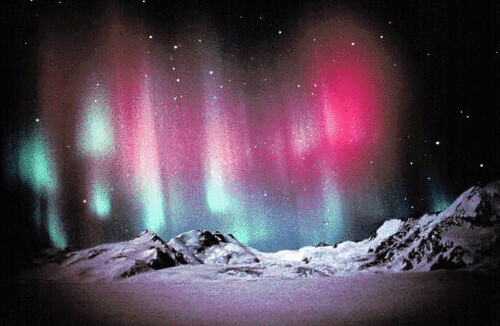 [Image: The aurora borealis – yes, the Northern, not Southern, Lights. Sorry. Via NASA]. [Image: The aurora borealis – yes, the Northern, not Southern, Lights. Sorry. Via NASA].A hundred thousand years later, the cathedral reaches the sea, where its vast internal voids are broken open and revealed in the glacial cliff face. Sections of nave and pulpit can be found floating in the water, sculpted rims of prayer-domes drifting north in the smooth surfaces of icebergs. Here and there a complete chapel; elsewhere a crypt, its tombs' chiseled inscriptions melting slowly in the sun. Some future group of Argentine architectural students will then take a field-trip there, sketchbooks in hand, and they'll spend two weeks back-mapping the precisely measured structure to its original, geometric clarity. 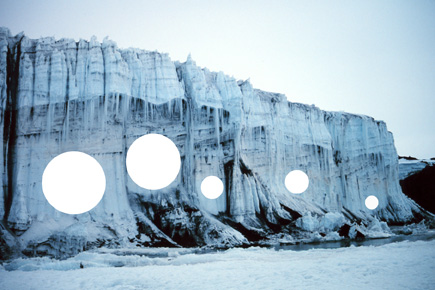 [Image: The BLDGBLOG glacial cathedral, adapted from this photo, ©Michael Van Woert/NOAA NESDIS/ORA]. [Image: The BLDGBLOG glacial cathedral, adapted from this photo, ©Michael Van Woert/NOAA NESDIS/ORA].Another hundred thousand years later, there's no trace of the cathedral at all.
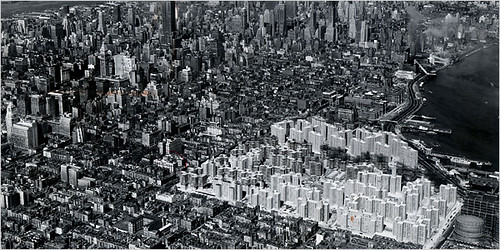 [Image: Stuyvesant Town and Peter Cooper Village, from the New York Times]. [Image: Stuyvesant Town and Peter Cooper Village, from the New York Times].
"Jerry Speyer, a real estate investor who controls some of [New York City's] most prominent icons, like Rockefeller Center and the Chrysler Building, signed a deal today to buy 110 apartment buildings along the East River in Manhattan for $5.4 billion," the New York Times reports. "The unremarkable brick buildings are set among trees and fountains on 80 acres of some of the most valuable land in the country."
As one rumor flying around the BLDGBLOG offices here would have it, four of the buildings are to be set aside from all future resale and permanently locked; what goes on inside will be revealed by a series of horrifying documentaries aired on MSNBC in A.D. 2023...
That, or Mr. Speyer will die of a heart attack within two years and bequeath the whole site to an unsuspecting nephew – whose Romantic sensibilities will lead him to expel all tenants, then fence off the whole area against public intrusion; he will thereafter wander alone through 80 acres of abandoned tower blocks, wearing a hood, watching autumn leaves accumulate, writing the occasional sonata... When the rest of New York – and the world – is devastated by an outbreak of bird flu, this lone heir will survive on tomatoes and grains grown in his own small greenhouse, drinking his way through a cellar of wine, shooting rats, looking out across the rooftops of his own derelict city – upon the other derelict city that now surrounds him.
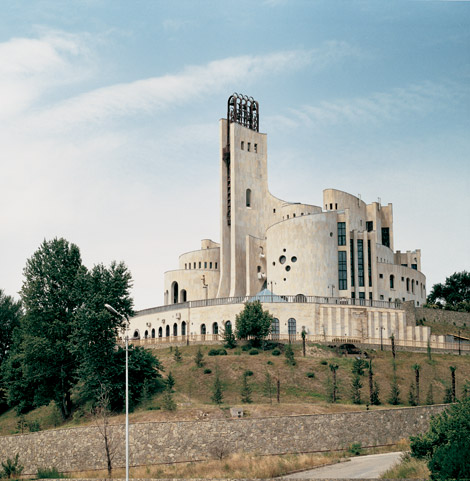 [Image: ©Frederic Chaubin, Wedding Palace (Tbilisi, Georgia, 1985). Last month, PingMag ran a short interview with photographer Frederic Chaubin. Chaubin has spent the last several years documenting Soviet-era architecture in post-Soviet nations, with a focus on the odd, the unique, and the eccentric. "If you see the photographs all together in a small space like here, you might feel like there are quite a lot of these buildings around, but actually there are very few of them. You have to imagine that if you go to each Russian town you will only find one or two very special buildings there. But most of them are very boring and look very similar, and those here are the exceptions." I just like the above building, really]. [Image: ©Frederic Chaubin, Wedding Palace (Tbilisi, Georgia, 1985). Last month, PingMag ran a short interview with photographer Frederic Chaubin. Chaubin has spent the last several years documenting Soviet-era architecture in post-Soviet nations, with a focus on the odd, the unique, and the eccentric. "If you see the photographs all together in a small space like here, you might feel like there are quite a lot of these buildings around, but actually there are very few of them. You have to imagine that if you go to each Russian town you will only find one or two very special buildings there. But most of them are very boring and look very similar, and those here are the exceptions." I just like the above building, really].
The New York Times last week introduced us to a "giggling guru" named Maharishi Mahesh Yogi. In addition to laughing quite a lot, one of his apparent goals "is to rebuild the world according to Vedic principles. He has called for the demolition of 'improperly oriented' buildings, believing them to be toxic, and includes among them the United Nations and the White House. There are proposals for New York and Paris to be cleared to make way for 3,000 marble peace palaces. (His organization operates such palaces in Bethesda, Md., Lexington, Ky., Houston and Fairfield.) Maharishi is also convinced that every country's capital is wrongly located. In India and America, his organization has bought land near what it calls each country's 'brahmastan' – or the geographical and energy center. The future capital of the United States would be Smith Center, Kan., population 1,931." (Thanks, David! Also at Archinect).
 [Image: It's an interstellar Kansas, where cosmic tornadoes form. "Light-years in length," this is a jet of energy and molecular excitation "associated with the formation of young stars" – though "the exact cause of the spiraling structures apparent in this case is still mysterious." Thanks, Jason!]. (Earlier: Struck by loops).
Several months ago, BLDGBLOG featured a collaboration with Leah Beeferman, a Brooklyn-based artist and the graphic designer for Cabinet magazine. That project was the Helicopter Archipelago. 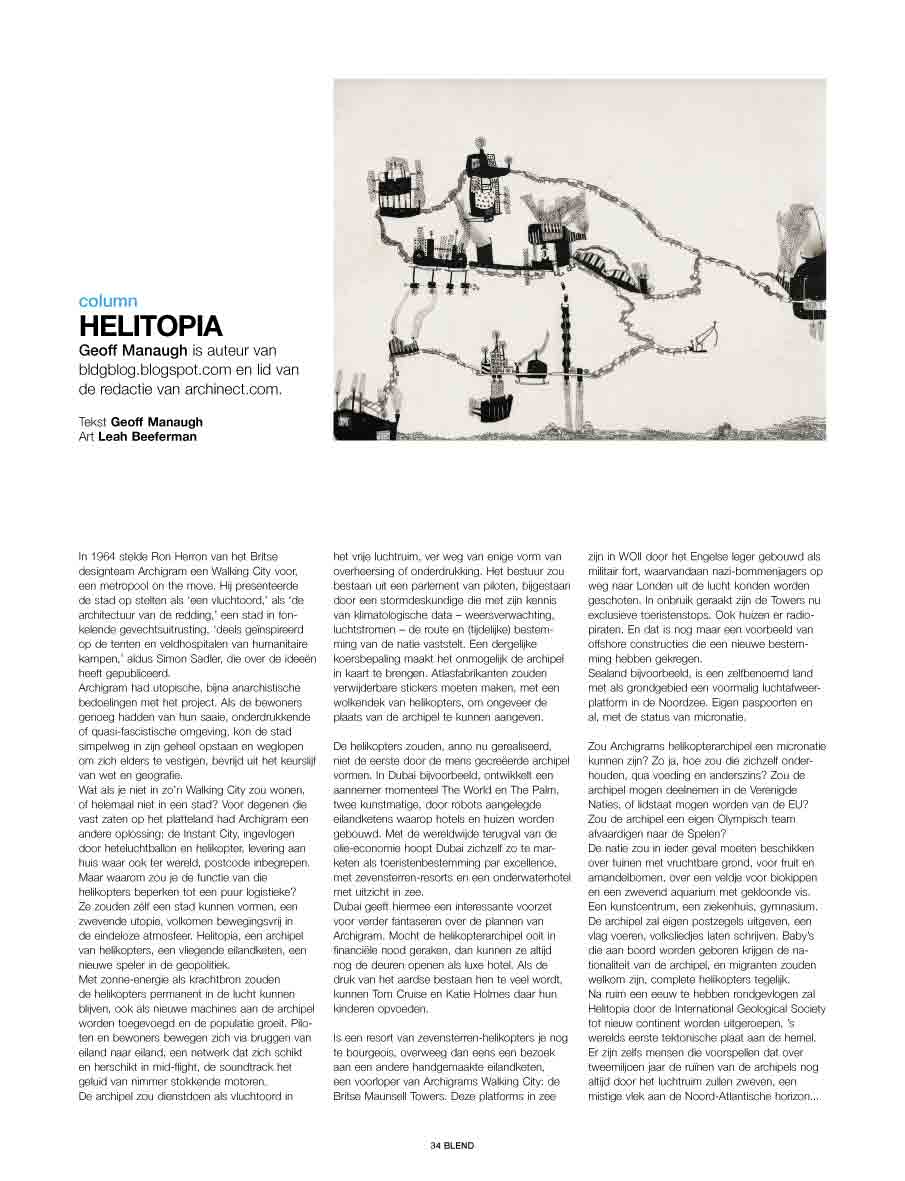 The Archipelago was first published in Blend, however, a Dutch arts & culture magazine; and, having recently gotten hold of some PDFs from Blend's design team, I thought I'd post a quick glimpse of the page spread. (Sharp-eyed readers will notice that the text is in Dutch). So, in case you missed it the first time round, the helicopter archipelago is an independent micronation of solar-powered helicopters, a flying island chain: A kind of flying Hawaii, or anti-gravitational Micronesia, with tanned deck-hands leaping across aerodynamic tailfins to the soundtrack of ceaseless enginery, the helicopter archipelago would act as an escape hatch from traditional, nation-state sovereignty. Its government would be a parliament of pilots, led by experts in storms, whose access to climatological data – future weather, air speed, barometric pressure – would determine the nation’s route and direction.
Never leaving the international airspace of unregulated trade winds, the archipelago would be impossible to map. Atlas-makers and manufacturers of globes will simply include a pack of removable stickers, featuring small clouds of helicopters, to approximate the country’s location… Further: Once the archipelago is aloft for more than a century, the International Geological Society will declare it a flying continent, the world’s first airborne tectonic plate.
Some speculate that, two million years from now, the archipelago’s ruins will still hover in the sky: a ghostly blur across the north Atlantic horizon… In any case, you can read more at the original post – whilst also stopping by Leah Beeferman's website to see her other work, including drawn circuits and these assorted architectural explorations. In the latter link, don't miss Leah's "box factory" (2005) and "built" (2004). Meanwhile, I have five or six more columns from Blend to republish here, so expect to see those in the next few weeks.
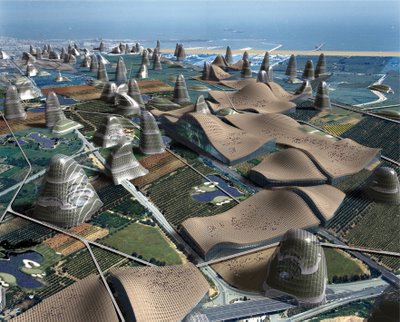 [Image: Vicente Guallart, a Barcelona-based architect whose work explores the mineralogical remaking of whole terrains – including how to make a mountain]. [Image: Vicente Guallart, a Barcelona-based architect whose work explores the mineralogical remaking of whole terrains – including how to make a mountain].Two articles have appeared in the last ten days or so about the impact of landscape on animal evolution. In the first case, New Scientist reports, "one of the biggest mountain chains in the Earth's history may be responsible for the explosive diversification of animals more than 500 million years ago. Sediments washed from the mountains – dubbed the Transgondwanan Supermountain – added vital nutrients to the ocean, opening new evolutionary opportunities." According to the theory's main advocate, Rick Squire – whose research interests include "tectonic processes affecting the early evolution of animals" – it was all a question of landscape, the geochemical erosion of super-topographies into biologically accessible micro-nutrients: [T]he trigger was the collision of a series of three large continental blocks – roughly corresponding to Arabia, India, and Antarctica – with the eastern edge of Africa from 650 to 515 million years ago. The drawn-out continental impact raised a vast 1000-kilometres-wide mountain range that stretched for more than 8000 kilometres along the equator on the ancient land mass known as Gondwana. Heavy rains typically fall along the equator, which would have produced a high level of erosion – it was before the evolution of land plants. Squire's research group has traced the resulting offshore sediment deposits around the world, and say they eventually amounted to more than 100 million cubic kilometres – enough to cover the entire US up to 10 kilometres deep. So the explosion in animal life was a kind of unintended by-product of landscape design; the surface of the earth became food – and anatomical structure, in the form of "protective carbonate shells" – for new species. Leading to a question for landscape architects: how could your urban park design affect the bodily structure of future organisms...? 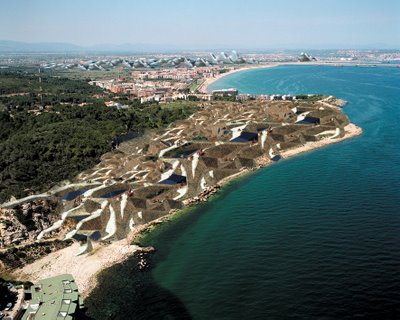 [Image: Vicente Guallart. Guallart's speculations about "how to make a mountain" include the following: "The geological structure of the hill, on the micro, the medium and the macro scales, offers us rules with which to put forward a mineralogical system that will guide its functioning." These are the internal rules of a landscape – and, Guallart implies, they can be reproduced architecturally]. [Image: Vicente Guallart. Guallart's speculations about "how to make a mountain" include the following: "The geological structure of the hill, on the micro, the medium and the macro scales, offers us rules with which to put forward a mineralogical system that will guide its functioning." These are the internal rules of a landscape – and, Guallart implies, they can be reproduced architecturally].Then there was an article published just yesterday about multi-million year extinction cycles in mammalian species, and how these cycles might actually be linked to " regular wobbles in Earth's orbit": Changes in the Earth's tilt and the shape of its orbit lead to climate cycles of around 1.2 and 2.4 million years. At their extremes both these cycles cause global cooling, expansion of polar ice sheets and changes in rainfall patterns. [Mammalian] extinction peaks coincided with global cooling maxima, while new appearance peaks coincided with periods of stable climate. First of all, I like the idea of "new appearance peaks," or moments in planetary history when speciation hits a kind of mutational warp-speed, and even your own generation might be the quiet origin of a new species. Cue X-Files soundtrack here.  [Image: Vicente Guallart. Guallart's terrestrial speculations continue: "The limestone of the hill and its rhombohedric crystals of calcite enabled us to conceive, at multiple scales, a crystalline genesis for the project." This thus forms a "coherent system, from the structure itself to its outer limit, that responds to a single system of crystallization. In this way, the skin, like soil in the hills, directly reflects the internal logic of the mass and its interaction with the environment." With these rules in place, Guallart says, his firm could make mountains]. [Image: Vicente Guallart. Guallart's terrestrial speculations continue: "The limestone of the hill and its rhombohedric crystals of calcite enabled us to conceive, at multiple scales, a crystalline genesis for the project." This thus forms a "coherent system, from the structure itself to its outer limit, that responds to a single system of crystallization. In this way, the skin, like soil in the hills, directly reflects the internal logic of the mass and its interaction with the environment." With these rules in place, Guallart says, his firm could make mountains]. Second of all, this intertwining – of plate tectonics, planetary rotation, large-scale topographical change, and the birth, death, and even wholesale pruning of genetic lines – surely has a place in landscape design courses. At the very least, a phenomenally great architectural pamphlet, or even course syllabus, could be written about the possibilities: artificial mountain chains spurring micro-speciation; gardens as centers of genetic novelty; even mega-earthworks and the architectural manipulation of continental drift. Which makes me wonder, for instance, since single architectural projects are apparently enough to cause earthquakes, that perhaps architecture itself could be used to over-weight the earth and thus guide, or subtly control, its changing rotation... thus destroying all mammalian life on the planet. Terrestrial weaponization. The next Bond villain. Or print t-shirts: Architecture is killing us all. (Similar thoughts appear toward the end of this post).
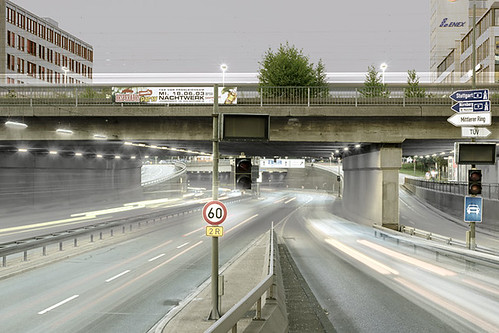 [Image: Thomas Weinberger, "Zone 60", München 2003]. [Image: Thomas Weinberger, "Zone 60", München 2003].Munich-based photographer Thomas Weinberger has a radiantly beautiful series of industrial and infrastructural landscape photographs called synthesen. The images are otherworldly, Ballardian, gemlike. The thick, almost surreal dimensionality of their lighting comes from Weinberger's technique, which is to combine two different photographs of the same scene – one taken during the day, one taken at night. His shot " Nizza" (2004), for instance, almost literally glows, the city burning with a white light as if liquid chrome has drowned the streets; while " Alexanderplatz" (Berlin, 2003) makes the Kaufhof look stroboscopically frozen, even extraplanetary or ossified. Then there's " Cracker" (2003), where we're greeted with an ESSO gas refinery in Ingolstadt – down to its shining vortices of pressure tubes and valving. " Zone 30" (Munich, 2004) looks like the opening shot of a sci-fi thriller about radiation poisoning in suburban Germany... Etc. The crispness – and gleaming, semi-symmetrical intricacy – of the shots totally amazes me. 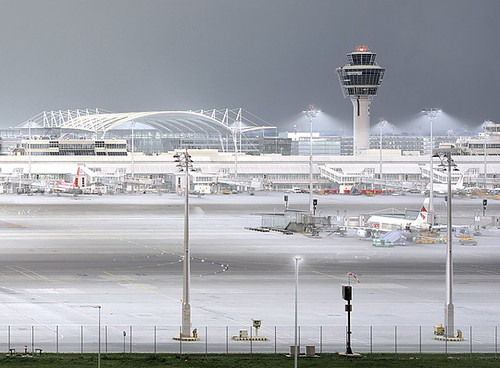 [Image: Thomas Weinberger, "Flughafen München" 2003]. [Image: Thomas Weinberger, "Flughafen München" 2003].Readers of German can download five short reviews of Weinberger's work; everyone else can just visit his website and gape. (Discovered via Alexander Trevi and juniorbonner; also seen at Conscientious, kottke.org, things magazine – and so on. For photos of a very vague aesthetic similarity see The Total Horizon).
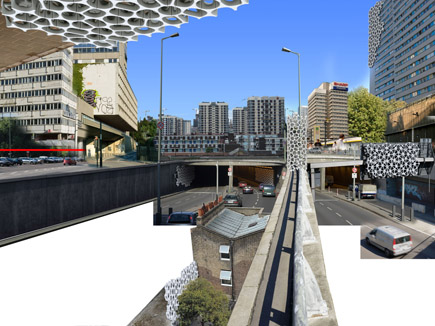 Over at WorldChanging, I've posted about "a decorative, three-dimensional architectural tile" by a Berlin- and London-based design firm called Elegant Embellishments. The tiles – algorithmic in design and modular in assembly – are built to reduce vehicular air pollution, including nitrous oxide and ground-level ozone; they can thus "rapidly improve urban environments in terms of air quality and visual appeal." According to the company's own press release: The tiles are coated with titanium dioxide (TiO2), a pollution-fighting technology that is activated by ambient daylight. TiO2 is a photo-catalyst already known for its self-cleaning and germicidal qualities; it requires only small amounts of naturally occurring UV light and humidity to effectively reduce air pollutants into harmless amounts of carbon dioxide and water. When positioned near pollution sources, the tiles neutralise NOx and VOCs (volatile organic compounds) directly where they are generated. They transform previously inert urban surfaces into active surfaces, re-appropriate polluted spaces for safer pedestrian use, and invert problem spaces – dark, polluted, uninhabitable – to benevolent spaces that benefit communities. 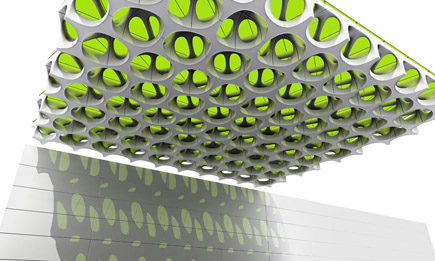 The rest of the post explores how the tiles can be used – how they assume "endless varieties of physical structures" even whilst being "composed with only two modules." Chemically scrubbing the air, so to speak, the grids also define respiratory oases within the city – becoming what Elegant Embellishments call "a recognizable symbol of a safer place to breathe." 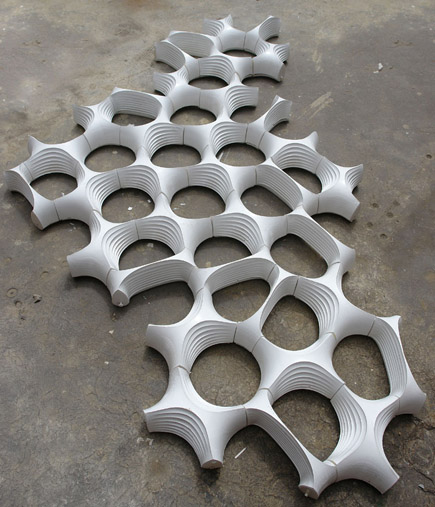 The piece ends by speculating about other, more explicitly artistic uses of the tiles – including how someone should install abstract, sculptural assemblages of them on plinths across London... Somewhere between an alien totem pole and a new artwork by Alexander Calder, the tiles could then mark pedestrian routes and historical sites, offering residents a geometric glimpse of the city's green future. Trafalgar Square, Berlin's U-Bahn, even J.G. Ballard's The Crystal World – all get thrown in for good measure. So check it out.
|
|
 [Image: Courtesy of Statoil].
[Image: Courtesy of Statoil]. [Image: Arnold Böcklin].
[Image: Arnold Böcklin].

 [Images: Constant vs. Statoil].
[Images: Constant vs. Statoil].

 [Images: Courtesy of Statoil].
[Images: Courtesy of Statoil].
 [Images: Courtesy of Statoil].
[Images: Courtesy of Statoil]. [Image: Courtesy of Statoil].
[Image: Courtesy of Statoil].
 [Images: Courtesy of Statoil].
[Images: Courtesy of Statoil].
 [Image: A passing Illinois lightning storm and supercell, the clouds peeling away to reveal evening stars; photo ©
[Image: A passing Illinois lightning storm and supercell, the clouds peeling away to reveal evening stars; photo © [Image: The old tower blocks of Chicago's
[Image: The old tower blocks of Chicago's  [Image: From
[Image: From  [Image: A future seafloor exploratorium. Image provided courtesy of the
[Image: A future seafloor exploratorium. Image provided courtesy of the 


 [Image: By
[Image: By  [Image: A related graphic, from the
[Image: A related graphic, from the  [Image: From
[Image: From  [Image: From
[Image: From  [Image: From the
[Image: From the  [Image: A visualization of project specifics; from
[Image: A visualization of project specifics; from 

 [Image: "An aurora borealis and the lights of Finland, Russia, Estonia and Latvia are featured in
[Image: "An aurora borealis and the lights of Finland, Russia, Estonia and Latvia are featured in 





 [Image: "Beardmore Glacier, slicing its way through the Transantarctic Mountains." Via
[Image: "Beardmore Glacier, slicing its way through the Transantarctic Mountains." Via  [Image: The aurora borealis – yes, the Northern, not Southern, Lights. Sorry. Via
[Image: The aurora borealis – yes, the Northern, not Southern, Lights. Sorry. Via  [Image: The BLDGBLOG glacial cathedral, adapted from
[Image: The BLDGBLOG glacial cathedral, adapted from  [Image: Stuyvesant Town and Peter Cooper Village, from the
[Image: Stuyvesant Town and Peter Cooper Village, from the  [Image: ©Frederic Chaubin, Wedding Palace (Tbilisi, Georgia, 1985). Last month,
[Image: ©Frederic Chaubin, Wedding Palace (Tbilisi, Georgia, 1985). Last month, 
 The Archipelago was first published in
The Archipelago was first published in 


 [Image:
[Image:  [Image:
[Image: 





